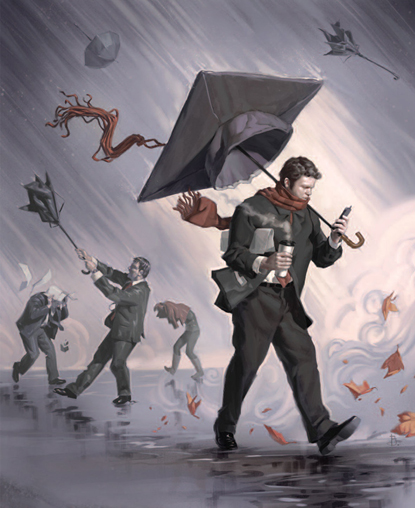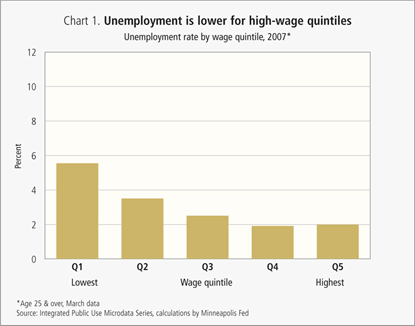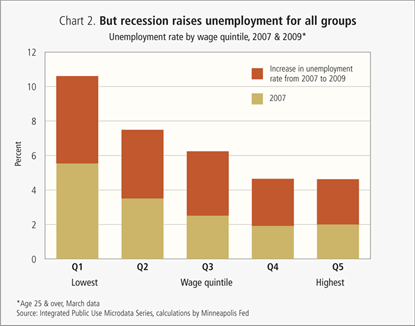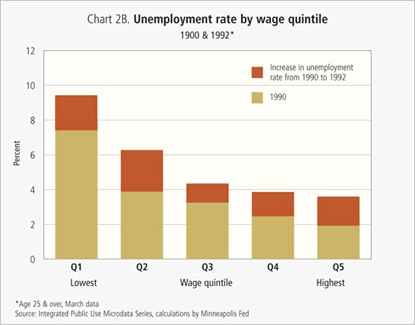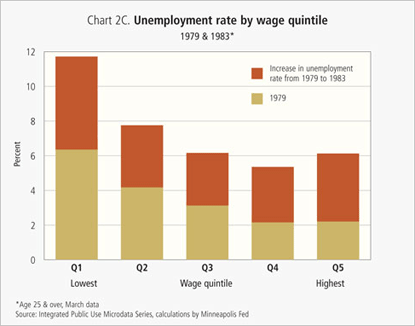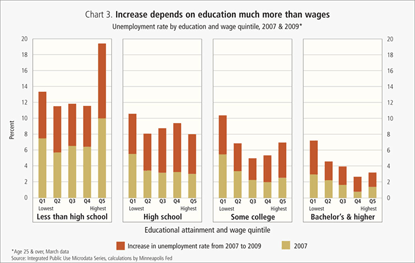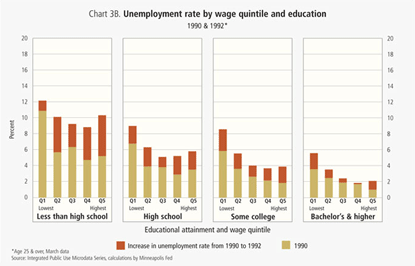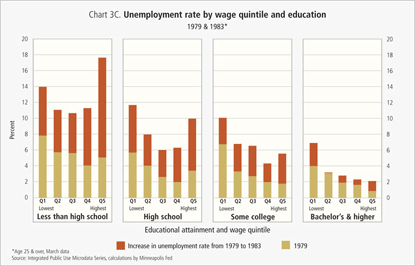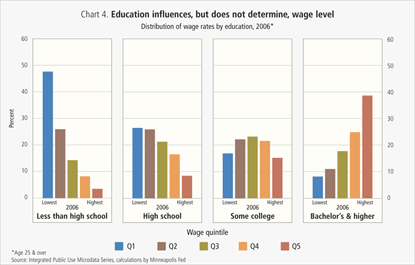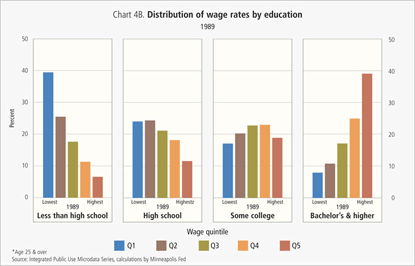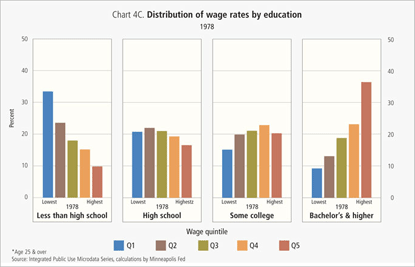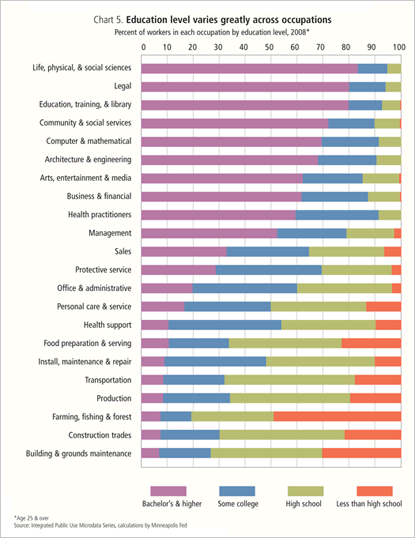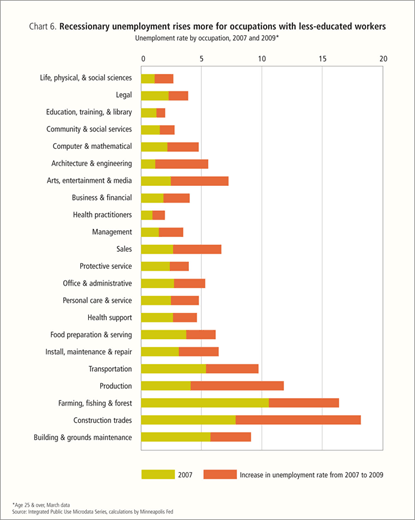Degrees of Job Security: Illustration by Tyler Jacobson (View Larger)
Recessions are not equal-opportunity events. A well-known feature of economic downturns, including the so-called Great Recession that ended in June 2009, is that some groups of people suffer job loss and sustained unemployment much more than others. While some workers hold onto their jobs or quickly find new ones, others lose their jobs, go months without work or even drop out of the workforce.
Most economic analyses have attributed this uneven distribution of economic hardship to demographic factors like education, age or race. Researchers have consistently found that less educated, young and minority workers are much more likely to be unemployed than the workforce as a whole.
In particular, numerous studies have highlighted the importance of education in avoiding joblessness—at all times, not just during recessions. In general, people with a college degree have much lower unemployment rates than those with less education. (In September 2010, the U.S. rate for college-educated workers aged 25 and over was 4.4 percent, less than half the rate for workers who hadn’t completed college.)
During economic downturns, poorly educated workers sustain bigger job losses than the better educated. For example, during the last recession, employment of workers with only a high school diploma dropped 5.6 percent, while employment of workers with a bachelor’s degree fell less than 1 percent.
These facts suggest that low-wage workers bear the brunt of job loss during recessions, while higher-wage workers go relatively unscathed. This seems logical, given what is known about the demographics of job loss; low pay is associated with youth, minority status and low education level. As a rule, young adults in their 20s and 30s usually make less money than middle-aged workers; people who didn’t finish high school typically earn less than college graduates.
But is this assumption true? During downturns, are high-wage workers destined to keep their jobs, while low-wage workers head to the unemployment line? For this article, we sought to answer this question by taking the unconventional approach of looking at recessionary job loss through the lens of wage structure rather than demographics. We found a more nuanced story about which workers suffer the worst job losses during recessions than the one implied by demographic factors alone. Contrary to expectations, high-wage workers are not spared job loss during recessions; their unemployment rate rises substantially, largely mirroring those of medium- and low-wage workers. This sharing of pain is seen, with some variation, in all recessions over the past 30 years.
How can this be, in light of the low unemployment rates of college graduates—all those corporate executives, software engineers and economists earning high salaries? It turns out that workers can’t be neatly categorized as well-educated and high-wage versus less-educated and low-wage. In labor markets, wages and education are closely correlated, but not joined at the hip.
The fact that recessions inflict significant job losses across the wage spectrum doesn’t mean that education isn’t important in avoiding unemployment; indeed, our analysis shows that it’s vital. The key insight is that education is linked to occupational choice, and during downturns, some occupations are hit harder than others. People who didn’t finish college are much more likely to work in industries that suffer larger employment declines during recessions. Some positions in those industries pay high wages, but a sheepskin offers better protection against joblessness than a big paycheck.
All in the same boat?
By definition, the unemployed don’t earn wages—they’re not working! But it’s possible to assess their wages before they lost their jobs in order to determine which workers—low- or high-wage earners—suffer the severest job losses during recessions. We analyzed 30 years of wage and unemployment data from the U.S. Census Bureau to trace the effects of the most recent recession and three others that have rocked the economy since the early 1980s.
A special supplement to the Census Bureau’s Current Population Survey (CPS) reports not only an individual’s employment status as of March of each year, but also how many hours he or she worked and how much he or she earned during the previous year. We use these data to calculate an average hourly wage for each worker aged 25 and over for the previous year. Then we assign all workers to five wage “bins,” or quintiles, for that year, ranging from lowest to highest. By counting how many workers in each wage quintile were unemployed as of March the next year, we can compute an unemployment rate for each wage group.
(About one-quarter of unemployed workers in March of each year didn’t work during the previous year and so were not counted in this study. This fact doesn’t reflect increases in long-term unemployment during recessions; the proportion holds true throughout the survey period, in good times as well as bad.)
Chart 1 shows the breakdown of unemployment by wage in March 2007, before the onset of the last recession. It confirms the notion, based on the unemployment rates of younger, less-educated and minority workers, that low-wage employees run the most risk of job loss, even in times of economic growth. The workers in the bottom fifth of the wage distribution have the highest unemployment rate; those in the top wage quintile have the lowest.
But the relationship between wages and unemployment changes when we compare the 2007 rates with those two years later, when labor markets were in the grip of the deepest and longest recession since World War II (Chart 2). As the economy headed south, the unemployment rate increased substantially across all wage quintiles. That’s to be expected, given that the national unemployment rate almost doubled to 8.6 percent between March 2007 and the same month in 2009. What’s unexpected is the similar magnitude of the increases across the board. Although the lower wage quintiles see bigger absolute increases than the upper quintiles (the rate for the bottom group rises about five percentage points versus less than three points for the top group), the jumps in the wage classes aren’t in proportion to the 2007, or “base,” rates. In fact, the proportional increases in unemployment rates for medium- and high-wage workers are greater than those for low-wage workers.
Compare unemployment rate by wage quintile for years 2000 & 2003, 1990 & 1992, and 1979 & 1983
This pattern—roughly similar increases in unemployment rates for all wage groups—is also evident in three previous downturns, starting with the 1981-82 recession. During the 2001 “dot-com” recession, high-wage workers not only experienced higher proportional increases in unemployment than workers who earned the lowest wages, but they also saw larger absolute increases in their unemployment rates. (For charts showing wages and unemployment in past recessions, see “The Recession and Recovery in Perspective.”)
Our finding seems to fly in the face of what we know—or think we know—about the characteristics of high- versus low-wage workers. If high-wage workers are insulated from job loss by virtue of their education, age, race and other demographic factors, how is it that they find themselves in the same boat as everybody else during recessions? Why do they experience unemployment increases about the same as those seen by workers earning lower wages?
Resolving this paradox requires looking at the CPS wage data from another perspective, taking into account the connection between unemployment and lack of education.
Education is destiny
The approximate symmetry of unemployment increases across wage classes during recessions evokes an image of common suffering—stockbrokers rubbing shoulders with gas station attendants in the job fair line: “Brother, can I borrow your iPad?” But an entirely different picture emerges when we consider the effects of educational attainment, as well as wages, on the likelihood of becoming unemployed.
In both booms and busts, there’s a strong inverse relationship between unemployment rates and education (see Chart 3). Regardless of wage level, joblessness declines as education increases (we focus on workers aged 25 and older because most of these workers have completed their education). Compared with the college-educated, workers with a high school education or less had higher unemployment rates in 2007 and saw bigger increases in unemployment during the Great Recession. This relationship between educational attainment and the risk of unemployment also holds for previous recessions (see “The Recession and Recovery in Perspective”).
(To put these statistics in perspective, college-educated workers account for a good chunk of the 25-and-over workforce: In 2006, about one-third of workers had a bachelor’s degree. In contrast, about 25 percent of workers had only a high school diploma, and a mere 10 percent were high school dropouts.)
The lack of job security afforded by high wages is striking: Workers with a high school education or less in the top wage class sustained large job losses during the last recession.1 Meanwhile, college-educated workers in the lowest wage quintile saw relatively modest unemployment increases during the recession.
Clearly, education—not wages—is the critical factor in determining which workers are likely to lose their jobs during a downturn. So why is the rise in unemployment during recessions so even across wage classes? The answer lies in the different career paths taken by workers with varying levels of education.
Belying occupational stereotypes, wage classes aren’t neatly demarcated along educational lines. In the aggregate, college-educated workers earn more than those with less education. But at the individual level, there’s considerable crossover—some workers with a college degree earn a journeyman’s wage, while some workers with only a high-school degree earn as much as a professional employee. Chart 4 illustrates the degree to which workers earn wages seemingly at odds with their academic achievements. In 2006, about 20 percent of workers with a college degree were in the lowest two wage quintiles, earning less than $14.50 per hour. Toward the other end of the education scale, 25 percent of workers with only a high school education fell into the top two wage groups, earning over $20 per hour.
Compare distribution of wage rates by education for years 1999, 1989, and 1978
For less educated workers, earning high wages is more difficult than it was a generation ago, because of the higher skills required for most higher-paying jobs today (see charts showing the shifting distribution of wages by education over the years in “The Recession and Recovery in Perspective”). This is the case even for blue-collar, clerical and other types of jobs that traditionally didn’t require a bachelor’s degree. In 1978, the proportion of high-school educated workers in the top two wage quintiles was 35 percent, compared to 25 percent in 2006. Nevertheless, the data show that it’s still possible for someone without a college degree to earn high wages. Conversely, some college graduates earn relatively low wages.
But when it comes to unemployment, education is destiny; workers tend to sort into different occupations based on their education level, and some occupations are more vulnerable to job loss during recessions than others.
Separated at graduation
The segregation of occupations on the basis of education can be seen in Chart 5. Workers with a high school education or some college training gravitate toward occupations that don’t require a bachelor’s degree, such as construction trades, food service and transportation. Some jobs in those occupational groups pay high wages; for example, construction managers can earn over $50 per hour.
But these occupations are concentrated in industries such as construction, manufacturing and hospitality that historically have hemorrhaged jobs during recessions. In March 2009, 18.7 percent of workers in construction trades during the previous year were unemployed, according to CPS figures. The jobless rate for production workers—a broad category that includes machinists and print technicians—was over 12 percent. Chart 6 shows that workers in occupations requiring less education suffered big increases in unemployment during the 2007-09 recession. (Recession-sensitive occupations also tend to attract males—one reason job loss hit men harder than women during the recession.)
College-educated workers, on the other hand, can take their pick of a wide array of occupations. Many put their verbal and analytical skills to use in white-collar or professional occupations such as management, law and teaching. Some highly educated workers toil for meager pay (think philosophy majors working as receptionists or bus drivers). However, their jobs come with a valuable fringe benefit: They cluster in industries that, compared with those that employ less-educated workers, are not as prone to job loss during downturns. Increases in unemployment during the recession were much less for occupations such as nursing, library science and social work.
The contrasting occupational choices—and consequently, recessionary fortunes—of college-educated versus less-educated workers explain why, when viewed through the prism of wages (back to Chart 2), unemployment increases were so similar across the board during the recession. Unemployment rates rose markedly for less-educated, high-wage workers, contributing to sizable overall unemployment increases for top wage earners. College-educated, low-wage workers saw smaller increases in unemployment, reducing the overall rise in unemployment for low-wage earners.
But this view obscures the underlying truth about joblessness during recessions: Education is the great divider in the labor market, channeling workers into different occupations according to their educational level. In a downturn, jobs filled by workers with a high school education or less are much more likely to disappear than those taken by college graduates.
A job security premium
The take-away message for young people weighing their career options in the wake of the Great Recession? If you want to keep your job during the next one, it’s better to be well educated than well paid.
At first glance, the data on unemployment and wages appear to contradict the idea that educational attainment, age and other demographic factors determine who suffers the greatest job losses during recessions. All wage classes—those associated with high socioeconomic status as well as those lower on the scale—see roughly comparable increases in unemployment during downturns. But a look at the Census data from a broader perspective reveals the crucial influence of education on the dynamics of recessionary unemployment.
It’s not richly compensated workers who are largely insulated from job loss during downturns; rather it’s workers—whether high- or low-wage—who continued their education beyond high school. Educational achievement is linked to occupation, which in turn has a strong bearing on the risk of unemployment.
College-educated workers as a group already enjoy a considerable wage advantage over less-educated workers; in 2009, the hourly wage of the typical U.S. college graduate was almost twice that of the average high school graduate.2 This wage premium has steadily risen over the past three decades. (College graduates also garner a disproportionate share of nonwage benefits such as vacation pay, employer-paid health insurance and pension contributions.)
Our analysis adds to a growing body of evidence that a college degree also confers a job security premium. Earning a bachelor’s degree—or at least attending college—greatly reduces the odds of joining the ranks of the unemployed in a faltering economy.
Endnotes
1 High-wage workers without a high school diploma suffered particularly large increases in unemployment, elevating their already high unemployment rate. This may be partly due to measurement error—the number of these highly atypical workers is small. However, the same pattern does appear in previous recessions.
2 See David Autor, “The Polarization of Job Opportunities in the U.S. Labor Market,” p. 5. Jointly published by the Center for American Progress and the Hamilton Project, April 2010.




